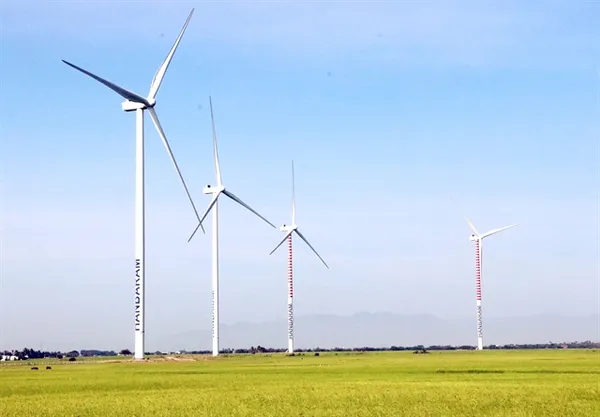 Business Beat
Business Beat

Analysts say the main reason for the tourist industry’s modest participation in the stock market is that a majority of its companies are too small and fear they will be ignored by investors.
 |
| A view of Bản Giốc fall in northern Cao Bằng province. — Photo 24h.com.vn |
Compiled by Thiên Lý
At the close on July 20 the share price of Tây Ninh Cable Car Tour Joint Stock Company (TCT) stood at VNĐ67,000, slightly up for the year but with a gain of 40 per cent from a year ago.
The company, founded in 2006, operates cable car systems for people and goods in Tây Ninh Province and is listed on the Hà Nội Stock Exchange.
Market observers attributed the sharp increase in the Tây Ninh-based company’s share price to its excellent performance.
Its gross margin in 2016 and 2017 was 80 per cent on average. The good results have continued in the first half of this year, with turnover and pre-tax profit being VNĐ130 billion (US$5.73 million) and VNĐ83 billion ($3.7 million), up 8 per cent and 1 per cent year-on-year.
It has been paying dividends consistently of around 30 per cent.
Hội An Tourist Service Company saw its shares zoom in March-April from VNĐ12,000 to VNĐ62,000 before giving up some of the gains to fall back to around VNĐ31,000.
Its profits rose from VNĐ9.4 billion in 2015 to VNĐ11.4 billion last year.
This year its target is VNĐ16.7 billion.
But the big picture is that despite good performances across the board, few tourism companies are listed.
According to the Việt Nam National Administration of Tourism (VNAT), the number of foreign tourists coming to Việt Nam in the first six months of 2018 surged 27.2 per cent year-on-year to 7.9 million.
Income from tourism is estimated at VNĐ312 trillion (US$13.5 billion), an increase of 22.5 per cent.
There are more than 2, 000 businesses in the tourism industry but only around 20 have listed on the country’s three stock markets, of which six provide entertainment services and 12 others are involved in hospitality.
The major firms include FDT (Fiditour), OCH (Ocean Tourist and Hotel Joint Stock Company), VNG (Thành Thành Công Tourist Joint Stock Company), DAH (Đông Á Hotel Group Joint Stock Company) but a few of them are listed including TCT and HOH.
Analysts say the main reason for the industry’s modest participation in the stock market is that a majority of its companies are too small and fear they will be ignored by investors.
Actually there are many large tourism companies such as Vietravel, Saigontourist, Sun Group, and Tuần Châu, but they have not listed either due to certain reasons.
State-owned Saigontourist for instance, though placed in the list of companies in which the Government wants to sell out its stakes in 2016-20 and a company whose shares are expected to be really attractive to investors, has yet to be equitised.
The HCM City-based company was founded in 1999 and offers tours ranging from seats on a coach, classic, cultural and soft adventure to vacation, Indochina, Vietnam – China, and private.
It runs 54 hotels and resorts with a total 8,000 rooms and eight travel companies, 28 restaurants and 13 tourism sites. It has join ventures with 50 domestic joint stock companies and nine foreign companies, and has operations in the US States, France, Germany, Switzerland, England, Belgium, Japan, Russia, South Korea, Israel, and Spain.
The listing of Saigontourist one day will finally draw attention to tourism shares.
Banks could find cutting loan interest rates hard
After falling several times recently the interbank interest rate has been rising strongly again since July 16.
On that day the rate on overnight loans rose by 48 basis points to 1.36 per cent.
The one-week rate was up by 41 points to 1.55 per cent, and the one-month rate by 53 points to 2 per cent.
Analysts say the rise in the interbank rates indicate a drop in liquidity, meaning banks would not be able to reduce lending interest rates as expected.
They attribute the rate hikes to instability at home and abroad, which is having a big impact on the country’s economy.
The US Federal Reserve’s interest rate hikes and the escalating US-China trade war have caused the dollar to strengthen.
On July 25 the buying and selling rates were VNĐ23,330 and VNĐ23,430 to the dollar.
Meanwhile, the Government’s top priority is to keep the economy stable and keep credit growth within reasonable levels to ensure the inflation target is achieved.
The Government’s pursuit of this goal lessens the opportunity even more for lenders to lower interest rates, the analysts say.
To achieve the goal of economic stability and amid the relentless weakening of the đồng against the greenback, the State Bank of Việt Nam recently sold more than US$2 billion worth of dollars to commercial banks to ease pressure on supply in the market.
This has taken VNĐ46 trillion worth of đồng out of the banking sector.
The analysts say this has occurred at a time when demand for credit in the economy is increasing to fund production of goods for the peak season at the end of the year.
The central bank’s move also immediately affected the interbank interest rate, driving it up by 2 percentage points.
To cope with the current instability the Government has to run a tight ship at least until things ease out, meaning the central bank might have to tighten monetary policy.
Besides macroeconomic issues, banks are also facing their own problems, one of which is the steady increase in a range of operating costs including employee compensation and benefits, information technology, legal fees, consulting services, and expenses associated with buildings and other fixed assets.
The analysts point out that this is one more reason banks would not be able to cut their loan interest rates.
The recovery of other asset classes including securities and real estate in recent times means they are attracting some of the money away from banks, affecting lenders’ liquidity and putting upward pressure on deposit interest rates.
This is a double whammy – there is not enough supply of liquidity and the cost of funds is high – for banks seeking to cut lending interest rates.
VN afraid of getting caught up in US-China trade war
Many business groups have called on their members to apply the smart and effective mechanism to local exports to prevent possible negative effects from the China-US trade war.
They said Chinese enterprises had increased orders for processing by Vietnamese products for export to the US.
It is thought that China could ship products to Viêt Nam for simple processing and then export to the US with the labels of Vietnamese enterprises affixed on them to avoid high tariffs.
This could bring short-term benefits to Vietnamese enterprises but cause a surge in exports of these products, resulting in a high risk of imposition of protectionist tariffs by the US Department of Commerce (DOC), the business groups warned.
Association insiders said if the DOC detected Vietnamese enterprises putting their labels on what are essentially Chinese products, it could target not only them but also companies in other sectors.
According to the Ministry of Industry and Trade, Chinese enterprises are likely to eye the Vietnamese textile and garment and leather footwear sectors since the two countries’ products are similar.
Việt Nam is the second largest supplier of textile-garment and leather footwear products to the US after China.
The business groups have urged authorities to tighten control over import of Chinese products subject to high tariffs in the US.VNS









